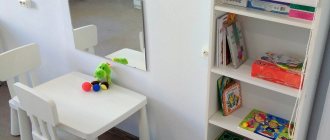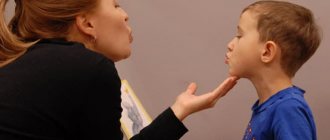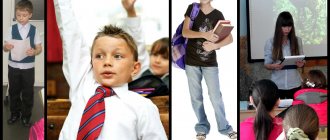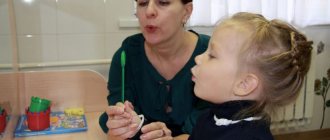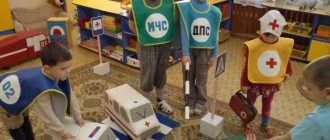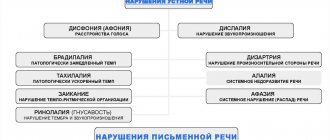Brief summary:
Speech disorders occur in children of different ages and manifest themselves in different ways: from difficulties in pronouncing individual sounds in coherent speech to the absence of phrasal speech as such or the presence of single babbling words and onomatopoeia in the active vocabulary.
It is very important to identify problems with a child’s speech development and overcome them as early as possible – in preschool age. The sooner you pay attention to the level of development of your child’s speech and the sooner you provide him with help, the more effective it will be, the more favorable the prognosis for his further development and subsequent schooling will be.
The dynamics of speech development of a child of early and preschool age largely depends on the active position of parents, who at this stage play a leading role in the correction process.
Parents can organize proper communication with their child, change the conditions of his upbringing, stimulate initiative in children's statements and motivation for verbal communication, work closely with specialists (speech therapist, psychologist, neurologist) to achieve faster and more sustainable results, etc.
Signs of speech disorders in preschool children:
— The child develops with a delay in general or motor development, and is registered with a neurologist and other specialized specialists.
— The baby suffered serious illnesses, including neurological diseases.
— In the pre-speech period, there was no active use of humming and babbling and their diversity.
— The first words appeared after 1 year 2 months.
— A child reluctantly and rarely repeats after an adult what he hears.
- When asked to “Repeat” or “Say it again”, he shows verbal negativism (remains silent or walks away, as if he did not hear the request).
— The child prefers to solve his problems on his own, without turning to you for help and does not express his request verbally (“independent” child).
— The child communicates equally actively/inactively with familiar and unfamiliar people.
“It doesn’t matter to the kid whether anyone understands him.” He speaks one language that he understands. He doesn’t respond to comments like “Say it again better.”
— Plays mostly silently, without commenting on what is happening.
— The child’s speech lags significantly behind the level of speech development of his peers.
Stages of speech formation:
- development of motivation (needs, aspirations, motivation for speaking and verbal communication) and the formation of imitative abilities to reproduce speech;
- expanding vocabulary and working on the grammatical structure of speech;
- development of dialogic and monologue forms of speech.
Tasks:
- development of understanding of addressed speech;
- clarifying the meanings of words that children have in their active vocabulary;
- getting to know new words and situations of their use;
- clarifying the meanings of grammatical forms present in children’s speech;
- mastering new grammatical forms and constructions and using them in independent speech;
- formation and improvement of the syllabic structure of words;
- formation of the skill of coherent dialogic and monologue speech;
- improving the sound aspect of speech.
The influence of speech problems on the process of formation of a child’s personality can be significantly weakened if early correction is started. This necessitates the need for special work to fill gaps in the speech development of children.
Corrective assistance provided during the sensitive period for speech between the ages of 2 and 5 years is effective, i.e. during the period when the speech function is actively developing. In this case, it becomes possible to “coincide” with the natural timing of the formation of the beginnings of speech and avoid secondary layers. As a result, it is possible to achieve full compensation for speech disorders even before the child enters school.
Prevention of speech disorders in preschool children
Due to the increasing number of newborns with disabilities in psychophysical development, correctional speech therapy and socio-psychological assistance to children at an early age should be a priority.
However, the speech therapy system often does not cover young children.
In the existing healthcare and education system, specialized care is provided to 68% of children with speech pathology after the age of 5, when the speech defect has already become entrenched.
With age, the possibility of plastic changes in the child’s condition is lost, and the conditions for compensation and correction worsen. In severe cases, speech pathology leads to a limitation of communicative, cognitive, and activity capabilities, social failure, difficulties in schooling, and a deterioration in the child’s quality of life (V.P. Gudonis).
In order to help children cope with the complex tasks awaiting them, you need to take care of the timely and complete formation of their speech. This is the main condition for successful learning. After all, thanks to speech, the development of abstract thinking occurs; with the help of words we express our thoughts.
What should be done to ensure that the child’s speech develops correctly, in time for the baby to grow into a social being?
After all, A.S. Makarenko said: “Prevention of unwanted manifestations is a difficult process, but very important in the formation of a child’s personality.”
Solving these problems is inextricably linked with prevention and timely detection of deviations in the physical, neuropsychic and speech development of children.
Causes of speech disorders:
- deterioration of the environmental situation;
- features of the Ural region in terms of iodine and fluorine deficiency;
- an increase in the number of pregnancy pathologies;
- increase in the number of birth injuries;
- weakening of children's health and increase in childhood morbidity;
- various social reasons.
- First of all, it should be noted that the level of linguistic culture of society as a whole has decreased. Children often hear around them not only incorrectly formatted speech, but also far from literary expressions. In some cases, the content and speech design of television programs and videotapes leaves much to be desired.
Improper speech environment and upbringing can also cause speech defects in children (type of distortion). In this state of affairs, a small child is not able to perceive the linguistic norm of his native language, the articulatory structures of the sounds of audible speech, and he develops an incorrect or inaccurate perception of speech sounds. And this, in turn, leads to the appearance of sound pronunciation defects.
Disturbances in the sound culture of speech that arose in preschool age can subsequently lead to a number of secondary speech disorders: underdevelopment of phonemic hearing, delayed formation of skills in sound, syllabic and letter analysis of words, impoverishment of the child’s vocabulary, violation of the grammatical structure of native speech.. Therefore, it is so. It is important to take care of the timely development of children’s speech, paying attention to its purity and correctness.
As noted earlier, a child’s speech is formed in the process of communication with the adults around him. In this sense, a large role in the formation of children’s correct speech belongs to teachers of preschool institutions. If one of the tasks of a speech therapist is correction of speech defects in the case of abnormal speech development of a child, then the task of the teacher is to form the speech of children with normal speech development.
The education and training program in kindergarten provides for the development of all aspects of oral speech: vocabulary, grammatical structure, coherent speech, sound pronunciation.
Thus, nurturing the sound culture of speech is an integral part of the system of work on speech development. The main components of the sound culture of speech are the rhythmic and melodic side of speech (intonation) and the sounds of speech (phoneme system).
The formation of the sound side of speech includes several stages:
- preparatory;
- stage of sound appearance;
- stage of sound assimilation and automation (correct pronunciation of sound in coherent speech)
They include:
- development of children's auditory attention;
- development of fine motor skills of fingers in children;
- development of mobility of the articulatory apparatus;
- clarification of the articulation and pronunciation of a sound or its evocation by imitation. After the birth of a child, one should very carefully monitor the course of its early development, noting any lag in this development or deviation from its normal course. So, if a child does not begin to hold his head up or sit up on his own at the right time, if he is delayed in starting to walk or in the appearance of his first words and phrase speech, then the reasons for these delays must be promptly clarified by specialists and the measures they recommend to level the position must be immediately taken. In this regard, the following general rule usually applies: the less time the lag from the norm continues, the easier it is to overcome it.
Tasks :
- Prevention of various diseases and childhood infections that occur with high fever (compliance with the timing of preventive vaccinations, exclusion of direct contact with patients, etc.);
- protection of the hearing organ from colds, from foreign bodies, from excessive noise (even during sleep), as well as timely treatment and mandatory “aftercare” of ear diseases;
- protection of articulatory organs, consisting of the following:
- prevention and treatment of rickets and the possible appearance of anomalies of the bone parts of the speech apparatus;
- eliminating cases of thumb sucking or constantly placing your hand under your cheek during sleep (the latter can lead to the formation of a so-called crossbite);
- early dental prosthetics in case of their premature loss, since tooth loss in children causes significant deformation of adjacent teeth and jaws (here we do not mean age-related change of teeth);
- timely surgery for clefts of the upper lip and palate, if the child has them;
- timely trimming of the short frenulum of the tongue (no later than 4-5 years, since by this time those sounds should appear in speech, the correct articulation of which is prevented by the short frenulum);
- protecting the vocal apparatus from colds, dust, vocal overload (excessive screaming, excessively loud and intense speech, etc.);
- protecting the child’s nervous system (excluding loud shouts, scary stories and all kinds of intimidation, a gentle approach to the child during any illness and for some time after its end, fighting roundworms, etc.); This type of prevention is especially important for the prevention of all kinds of neurotic speech disorders and, first of all, stuttering.
Concern for the correct speech development of the child should be expressed in the following:
- ensuring a favorable speech environment as a necessary role model (in terms of the absence of speech disorders in people around the child);
- encouraging the baby's babbling with facial expressions of joy;
- fostering an orientation towards the perception of the speech of others, for which you need to talk to the child as much as possible, starting from the first days of his life;
- slow and clear pronunciation by adults of simple words related to a specific life situation for the child, as well as clear naming of surrounding objects and actions performed, which will help the child gradually “begin” mastering speech;
- a clear pronunciation by adults of words incorrectly spoken by a child, designed to unobtrusively and gradually correct his incorrect pronunciation;
In the structure of the domestic healthcare, education and training system, there are specialized institutions for children with speech pathology, but not all young children are covered by timely not only preventive, but even correctional and developmental work. Most of them attend general education preschool institutions, where there is no early psychological, medical and pedagogical assistance to children.
Traditional preschool technologies do not take into account the characteristics of children with speech delays, which reduces the effectiveness of developmental activities. In this regard, there is a need to look for new forms of speech therapy work with young children.
Speech therapy work on the prevention of speech disorders in young children should be built taking into account the basic provisions of special pedagogy in the field of early intervention (early targeted and differentiated “step-by-step” training; the use of specific methods, techniques, teaching aids; deeper differentiation and individualization of education; mandatory inclusion parents into the developmental process (A.A. Semenovich).
In addition, the work should be based on the following principles:
- the principle of complexity, which consists of a medical and psychological-pedagogical impact on the entire complex of speech and non-speech abnormalities of the child, based on the coordinated activities of all specialists (neurologist, psychologist, speech therapist) and parents;
— the principle of relying on various analyzers, which involves participation in the formation of higher mental functions of the visual, auditory, kinesthetic and motor functional systems;
— the principle of phasing, ensuring continuity and continuity of stages of preventive work;
— the principle of taking into account the zone of proximal development (according to L.S. Vygotsky), which involves providing the child with tasks of a certain level, the implementation of which is possible with measured help from an adult. In this case, the level of psychomotor and speech development of the child should be taken into account;
- the principle of complicating the material, which involves the gradual inclusion of difficulties in developmental work;
— the principle of visibility, which involves the use of visual aids in classes with children, which ensures the assimilation of the content of the task and the achievement of a specific result;
— the ontogenetic principle, which requires taking into account the sequence of formation of the psychomotor sphere and types of activity of the child (including speech activity) in ontogenesis;
- the principle of implementing the activity approach, which presupposes at an early age reliance on the leading type of activity - objective activity that contributes to the mental development of the child as a whole: the development of motor skills, perception, thinking, speech, etc. (A.A. Wenger, Yu.S. Shevchenko).
In the specialized literature, the issues of diagnosing and correcting deviations in speech development in young children are discussed by many authors. All of them highlight the following areas of preventive and developmental work with young children: development of visual and auditory perception, emotional reactions, normalization of muscle tone and the functioning of the organs of the articulatory apparatus, hands and fingers, development of general movements and actions with objects, normalization of breathing, development of understanding speech and prerequisites for active speech, development of interaction between an adult and a child.
Article:
End of the 20th century characterized by deteriorating children's health. According to data provided by Academician of the Russian Academy of Education A.G. Khripkova, only 14% of children are practically healthy, 50% have functional abnormalities, 35-40% have chronic diseases. In our country, much attention is paid to correctional, educational and pedagogical work with children suffering from speech disorders. Significant progress has been made in addressing issues of early diagnosis of speech disorders, methods and organization of correctional education and training of children. By means of special influences on children, in many cases it is possible to prevent or slow down the appearance of various deviations from the norm, in particular speech pathology. Timely prevention of speech disorders in children is closely related to the prevention of neuropsychic abnormalities in health. It is provided by a complex of measures, including therapeutic, pedagogical and social influences. Specialists from children's clinics, along with constant dynamic observation, conduct preventive examinations of children from 0 to 14 years old not only in the clinic, but also in preschool institutions and schools. The joint work of doctors and teachers in children's pedagogical institutions makes it possible to early treat deviations from the norm in the state of children's health, congenital and acquired diseases that affect the development of speech or contribute to the emergence of speech pathology. Of great importance in developing the problem of preventing speech disorders is the study of factors that ensure normal speech development in children. This knowledge is directly related to the hygiene of speech development, which is the most important indicator of a child’s neuropsychic health. Its objectives mainly boil down to studying the age stages of speech ontogenesis and identifying conditions (including the external environment and social conditions) that positively or negatively influence speech development. Recommendations and standards for the psychophysiological conditions of raising children are being developed, incentives for a child’s mental development and the possibilities of their use are being scientifically substantiated, and mass propaganda of psychological and pedagogical knowledge among the population is being organized. The prerequisites for the normal development of the younger generation are created by measures to protect the health of the population as a whole. One of the important directions in the development of speech therapy assistance to the population is the prevention of speech disorders and the consequences of speech pathology. This special branch of speech therapy faces the following tasks : a) prevention of speech disorders - primary prevention; b) preventing the transition of speech disorders to chronic forms, as well as preventing the consequences of speech pathology - secondary prevention; c) social and labor adaptation of persons suffering from speech pathology - tertiary prevention.
Primary prevention .
1. The implementation of preventive health care and special pedagogy begins even before the birth of the child by creating the most favorable conditions for the expectant mother during pregnancy , regulated by relevant laws and provided by the entire maternal and child health service. At the end of the 20th century, the health of the younger generation depends on a number of conditions related mainly to ecology and its influence on the immune, nervous and endocrine systems. Pollution of air, water, and soil leads to an increase in acute and chronic (especially allergic) diseases and a decrease in the body's resistance to harmful influences. Along with this, the role of stressful psychological influences is increasing, which in turn worsens the neuropsychological health and immunity of children. It is clear that the quality of all aspects of parents’ health also continues to decline, and with a family history, children are 2-3 times more likely to suffer from the same illness as their parents. In the system of psychoprophylactic measures, timely genetic counseling of future parents is essential in order to prevent the development of certain deviations in the neuropsychic and, in particular, speech development of the child. In cases where a family burden of any pathology is discovered, parents should be well informed about the possible manifestation of the disease in the child, as well as what preventive measures will prevent or reduce the symptoms of the hereditary disease.
2. With the birth of a child, special responsibility for his mental health falls on the family, which makes the psychological and pedagogical education of young parents especially relevant. The formation of a child’s character and personal characteristics begins from a very early age. Already the early period of postnatal development is of great importance for the subsequent stages of the formation of his psyche. Sleep, cry, movements and other physiological reactions of the newborn’s body reflect the safety and level of maturity of the central nervous system. Therefore, parents, together with doctors, should carefully monitor the formation and development of these reactions and take the necessary preventive measures in case of their deviations from the norm. In the 60s, the concept of “risk factor” appeared in the scientific literature, which refers to various conditions of the external sphere (biological and social) and the individual reactivity of the body, which, to a greater or lesser extent, contribute to the development of certain pathological conditions. There is a close interaction between biological and social risk factors. Biological risk factors for the development of speech disorders are pathogenic factors that act on the body mainly during the period of intrauterine development and childbirth, brain infections and injuries suffered after birth, and a family history of speech disorders. The primary defect in newborns can be hearing, vision, or motor impairment, both in an uncomplicated form and in various combinations of several primary defects. Biological risk factors for speech disorders of a genetic nature include, in particular, a violation of the formation of a psychomotor profile (left-handedness and various variants of incomplete right-handedness). In some cases, it is possible to prevent the development of left-handedness if, from an early age, a child tries to give objects only to the right hand, carefully but persistently transfers objects from the left hand to the right (spoon while eating, etc.), and uses predominantly the right hand when playing. , allowing the child to feel or guess an object with the right hand, etc. Biological risk factors for speech disorders also include a family history of speech pathology. It is known that a hereditary predisposition to the occurrence of a particular pathological condition is not fatal. As a rule, speech disorders do not occur against the background of complete health. In cases where, along with a hereditary burden of speech pathology (for example, stuttering), disorders of the central nervous system are diagnosed in children, specialized medical and speech therapy care is needed, taking into account the data of the child’s psychophysical and speech development. If signs of any deviations from the norm appear in pre-speech reactions (screaming, humming, early stages of babbling) and in speech ontogenesis itself, speech therapy assistance is recommended as early as possible. Parents should consult a speech therapist about the rules of their speech communication with their child. It is the speech of parents that becomes the model for the speech development of children, and therefore, in some cases, speech communication with the child of persons suffering from speech pathology should be limited. For the purpose of primary prevention of speech disorders in a child from a family burdened with speech pathology, it is necessary to begin speech therapy classes in early preschool age. Socio-psychological risk factors have attracted much attention from researchers in recent years, especially the issues of mental deprivation of children . Deprivation is insufficient satisfaction of basic needs (emotional and sensory). There are cognitive and social deprivation (I. Langmeyer, Z. Matejczyk, 1984). It has been established that all types of deprivation significantly affect the child’s speech development. Separation from the mother at an early age, characterological characteristics of the mother (anxiety, suspiciousness, infantility, impulsiveness, emotional coldness); rejection from mother (father); single-parent family; conflictual relationships in the family, changes in family structure (death, illness of loved ones, divorce, etc.); being raised in two homes; a sharp change in life stereotype and type of upbringing; inadequate type of upbringing (“idol”, overprotection, underprotection, inconsistency in the educational positions of parents). After 2.5 years and older, such influences as punishment at home and especially in a child care center, reluctance to attend a nursery or group, fear when meeting unfamiliar faces, animals, fear of negative fairy-tale characters, etc., become important. As the child grows and develops the range of psychotraumatic situations is significantly expanding due to the increasing importance of environmental influences. These are conflictual relationships with peers and adults, excessive punishment, intimidation, experiencing a situation of fear (the sudden appearance of a frightening animal, watching a “scary” movie, a “scary” fairy tale), the birth of another child in the absence of readiness to take the position of an elder, etc. Taking into account the patterns of action of factors risk allows you to purposefully carry out primary preventive correctional and pedagogical work. To organize rational methods of preventive pedagogical influence, knowledge of the age-related characteristics of the development of speech function and the psyche as a whole is important. For the timely development of speech, the mother and other people surrounding the child must constantly communicate with him, trying to evoke a response. It is known that in the very early stages of a child’s postnatal development, his communication with his mother is not silent, they conduct a “dialogue.” This “dialogue” causes reactions in the baby in the form of revitalization of general movements, smiling, pronouncing sounds and consonances (echopraxia, echolalia). Stimulating the formation of speech function is of great importance for the development of the child. Every effort should be made to ensure that the period of the child’s mastery of motor skills (sitting, crawling, walking, fine movements of the hands, etc.), and in particular the speech motor apparatus, proceeds favorably. It is necessary to create conditions for the implementation of various motor reactions, to promote the “games” of the baby with his voice. The formation of speech motor function is closely related to the development of general motor skills and in particular with the manipulative activity of the hands. In children of the first years of life, the development of speech understanding is of particular importance, which largely depends on the speech behavior of adults. A child understands speech by establishing a connection between words spoken by adults and objects surrounding the child. It is necessary to explain to parents that they are doing wrong in cases where they try to guess the child’s wishes by facial expressions and gestures. At the same time, he does not have the need for vocal reactions and utterance of sounds and words. The linguistic education of a child should begin early and in the first years of life should be carried out in the native language (K. D. Ushinsky, 1948-1952; E. I. Tikheyeva, 1981, etc.). Mastering two language systems at an early stage of speech development is a difficult task for a child. If a baby hears, in addition to his native language, another language, then his speech may develop more slowly, and in some cases numerous iterations appear, sometimes turning into hesitations of a convulsive nature. In this regard, mutual understanding and a unified approach must be established in the family, which will allow the child to subsequently master two or more language systems.
3. The family must know the requirements that must be made for the child’s speech. These requirements should be neither too low nor too high. Speech skills need to be developed according to age standards. During the initial period of speech development, one should not overload the child with mastering words that are difficult to pronounce and obscure, or with memorizing poems and songs that are not age appropriate. In cases where surrounding adults have incorrect pronunciation or, having fun, copy the child’s speech (“lisp”), the process of mastering correct sound pronunciation becomes difficult, abnormally pronounced speech sounds are reinforced, and in the future such a child may need special corrective training from a speech therapist. The people around the child, with their smooth, clear articulation and calm speech, encourage him to imitate the design of a speech utterance. If a child develops a rapid rate of speech, “choking” with words, an “avalanche-like” development of vocabulary accumulation and the development of phrasal speech, a special speech regime is needed to limit the introduction of new words and concepts into the child’s vocabulary and, in general, speech load. During this period, the child should be protected from being in conflict situations and from participating in events that are emotionally significant for him. The socio-psychological environment must be specially organized for him in order to stabilize his emotional state. You can help the development of normal speech by learning short rhythmic poems and songs with your child, singing and reciting to accompany movements performed at a certain pace (for example, when marching). It is necessary to teach the child to speak at a moderate speed. You need to talk to children in a calm tone, pronouncing words clearly and finishing the endings. Sensory education and the development of play activities are of great importance for the development of speech. The formation of speech function should be carried out in parallel with the study of the environment. Correct perception of objects, accumulation of ideas and knowledge about them occurs due to the close interaction of speech and sensory development. The most important means of mental development is children's play. Free from the movement of utilitarian, and, up to a certain age, socially prestigious goals, the game has that self-goal and self-worth that direct it to solving creative problems. Children's play is motivated by the needs of cognition and the need to acquire knowledge and skills that they will only need in the future. Children should have a variety of toys and aids for their independent use to develop fine motor skills, design, etc. The inclusion of didactic games promotes the child’s sensory development, forms concepts, develops the ability to learn, improves auditory attention, speech articulation and speech in general. The selection of toys and aids, and techniques for guiding adults in children’s play should be carefully thought out and learned by educators in connection with their influence on the development of children’s speech. The development of differentiated auditory and phonemic perception is a necessary condition for children to successfully learn to read and write in the future. A child’s readiness to learn to write and read is inextricably linked with the ability to understand the sound structure of a language, that is, the ability to hear individual sounds in a word and their specific sequence. Teaching children to distinguish sounds leads to the development of both attention to the sound side of speech and auditory memory.
4. Great responsibility in organizing measures to prevent neuropsychic disorders leading to speech disorders in children rests with preschool institutions . In the process of educational work, they consistently implement the tasks defined by the program in the field of physical, mental, moral and aesthetic development of the preschool child. To date, there are scientifically substantiated psychological and pedagogical recommendations on the regime of preschoolers and educational influences. However, in a number of cases there are individual reactions of children indicating a violation of the child’s adaptation to new living conditions. Thus, the initial period of a child’s stay in a nursery is sometimes accompanied by a delay and even regression of previously achieved development. In the first days after entering the nursery, some children's speech activity sharply decreases, which undoubtedly delays the formation of speech. This period can last for younger children up to 4 months, for older children up to 2 months. Adaptation to a child care institution is most difficult if the child enters it at the age of 9 months to one and a half years. It occurs least painfully before the age of 6-7 months and after one and a half years. Therefore, at an early age, an essential psychological aspect of the prevention of neuropsychic speech disorders, in particular, is the referral of the child to a child care institution at the age in which he can more easily adapt to new living conditions. Another way to adapt a child is to first bring the home regime closer to the conditions of a child care facility. It is necessary to accustom him to being away from home without close people. Being outside the family and adapting to these conditions develops cognitive mechanisms, his interest in new objects and people, which makes the child not only calm, but also active. Both at home and in kindergarten, the regime must be built in compliance with hygienic rules, of which one of the important ones is the development of physical activity in children.
5. The transition to schooling for children from the age of 6 places new demands on the child’s body. Psychophysiological studies of 6-year-old children show that this age represents a special turning point. It is at this time that the ability to follow certain rules of behavior is formed, to establish personal interactions with peers and adults, to coordinate one’s actions with the actions of other people, to be able to listen and follow the instructions of adults (V.S. Mukhina, 1975). These psychological characteristics are associated with a new, compared to a younger age, stage in the maturation of basic physiological systems, which is the most important condition for adaptive changes (both physiological and psychological). If a child has speech disorders, the need for timely diagnosis of the degree of functional readiness for school education increases. Only with specialists of various profiles can one decide with some certainty the question of the advisability of enrolling a child in school or granting him a deferment. The school plays a big role in protecting the neuro-mental health of children. The first weeks of a child’s stay at school are of particular importance in this regard. He is bombarded with a lot of new impressions and previously unfamiliar requirements, such as strict adherence to the rules of behavior, a long stay in a relatively motionless position, intense mental activity, etc. The appearance of a new person in the life of a small schoolchild who has unquestionable authority, as well as the inclusion of into a new diverse group of peers. Changing the usual way of life and adapting to new conditions of social existence require significant stress on all functional systems of the body. In children with speech disorders, the adaptation period is often painful: instability of attention, memory, and distractibility increase. They become irritable, often extremely excitable, restless, lose their appetite, sleep poorly, and have difficulty making contact with the teacher. Only gradually these phenomena decrease. The criteria for the onset of adaptation are a reduction in fatigue, restoration of appetite and sleep, and the establishment of normal relationships with the teacher and friends. The correct behavior of the teacher during this difficult period for a first-grader, his patience and kindness, the gradual inclusion of children in the educational load, and an individual approach make adaptation to school easier. The most important task of school mental hygiene remains the prevention of overwork and mental trauma in children, the creation of conditions at school that protect the nervous system of students from excessive stress. In this regard, great responsibility for the state of speech development of children and adolescents falls not only on the speech therapist, but also on the teacher, educator and class teacher. It must be remembered that oral speech in a schoolchild (especially in the lower grades) must be developed not only in terms of expanding vocabulary and developing its grammatical side, but also in terms of special training in its external sound design: developing rhythm, clarity of sound pronunciation, intonation expressiveness, i.e. that is, everything that helps strengthen speech motor stereotypy as a basal component of expressive speech.
Secondary prevention.
It is known that speech disorders affect the mental development of the child, the formation of his personality and behavior (secondary disorders). Profound speech disorders (alalia, aphasia) to one degree or another limit mental development in general. This occurs both due to the functional unity of speech and thinking, and due to a disruption of normal communication with others. The latter impoverishes knowledge, emotions and other mental manifestations of the personality. Predominant neurotic disorders in young children (V.V. Kovalev, 1976). There are four levels of predominant neurotic disorders in children: 1. Somato-vegetative - 0-3 years of life. 2. Psychomotor - 4-7 years of life. 3. Affective - 7-10 years of life. 4. Emotional-ideational - 10-15 years of life. The first level of neurotic disorders includes disorders of appetite, dysfunction of the gastrointestinal tract, thermoregulation, and sleep. The second level is associated with the appearance of hyperdynamic syndrome, tics, stuttering, mutism and other motor and speech motor disorders. At the third level of reactivity, children experience fears and depressive experiences. At the fourth level - neurotic anorexia, hypochondriacal overvalued formations of one’s “physical self”. The degree and nature of speech impairment and mental impairment determine the child’s ability to learn and actively participate in the public life of the school. School performance is hampered by the inability to ask, answer, tell or read in a timely and clear manner. Because of children suffering from speech disorders, the dynamics of the lesson are often delayed and discipline is violated (there is laughter, teasing, complaints, etc. in the class). Underdevelopment of the sound side of speech, insufficient development of phonemic processes and sound pronunciation prevent the timely formation of prerequisites for spontaneous mastery of practical skills in the analysis and synthesis of the sound composition of a word. This condition can be considered as the first consequence, creating significant difficulties on the path of children acquiring literacy. The second consequence can be considered the difficulties that children encounter in the process of mastering literacy. Lagging behind in their studies, schoolchildren who have speech disorders lose interest in learning and sometimes become categorized as discipline violators. Thus, the attention of the speech therapist should be maximally concentrated on the timely prevention of possible secondary, more distant consequences of speech pathology. From these positions, the state of the sound side of speech should be especially carefully analyzed, since insufficient development of phonemic processes, even with fully compensated defects in sound pronunciation, can lead to deficiencies in mastering writing and reading skills. In the process of raising children with speech disorders, parents and teachers need to constantly reflect on their behavior and their positions. Mutual understanding, encouragement, mutual respect, maintaining order, interaction both between family members and between teachers and parents play a serious role in the prevention of psychogenic reactive phenomena in children suffering from speech pathology. This provision is especially relevant for students who stutter. In cases where children experience psychological complications such as personal experiences associated with the presence of a speech defect, fear of speech, avoidance of situations requiring verbal communication, etc., the speech therapist needs to significantly increase the psychotherapeutic emphasis in his work. Each time, this emphasis and forms of psychotherapy will depend on the age of the child and the characteristics of the individual psychological response. Speech therapy prevention can be effective only if there is complete knowledge of the child’s development (physical, mental, speech, etc.) based on development standards. This will allow the speech therapist to specifically guide upbringing and training, using periods of sensitivity observed at certain stages of ontogenesis. Premature or delayed, in relation to the period of sensitivity, correctional training is less effective, while conscious reliance on the patterns of development of psychophysiological characteristics, psyche and speech allows the speech therapist to achieve significant success.
Tertiary prevention.
Some speech impediments limit career choices. Vocational guidance and training of persons suffering from speech pathology is included in the tasks of tertiary prevention of the consequences of speech disorders. The main focus of this stage is a deep consideration of the personal capabilities and interests of each student suffering from severe speech impairment. Such students should have the opportunity to choose, with the help of a teacher, psychologist, and doctors, a learning path that will allow this particular individual to achieve the best results. For this population of students, it is especially important to shift the focus of learning from cognitive development to emotional and social development. The goal of labor education for students in a school for children with severe speech impairments is to form among the younger generation a strong conviction that work is the main sphere of personal fulfillment. The school should prepare students for socially useful activities and participation in productive work.
Main directions of work on the prevention of speech disorders in young children
As a result of a theoretical analysis of the literature, it is possible to determine the main directions of work on the prevention of speech disorders in young children.
1. Formation of the motor sphere:
- normalization of muscle tone (general massage, physical education, differentiated massage of facial and oral muscles;
- differentiated massage of hands and fingers, self-massage of biologically active points);
- formation of a kinesthetic and kinetic sensation of manual and articulatory movements (perception of the body diagram, formation of a spatial sense, finger games, exercises to determine the position of the lips, tongue, jaw);
- exercises for the development of general, fine and articulatory motor skills (set of games);
- development of hand-eye coordination;
- development of self-care skills.
2. Development of higher mental functions:
- sensory-perceptual activity and reference ideas, memory (speech-auditory, visual, motor),
- attention (visual, auditory, motor),
- perception (visual, auditory),
- mental activity in connection with the development of speech (cognitive activity, visual-effective and visual-figurative thinking, mental operations, the ability to act purposefully),
- creative abilities,
- inter-analyzer interaction;
- formation of leading types of activities (subject, game);
- ensuring sustainable positive motivation in various activities.
3. Development of impressive speech:
- understanding words denoting objects, actions, signs;
- grammatical categories and prepositional structures;
- instructions, questions, simple texts);
4. Development of expressive speech:
- vocabulary (naming words denoting objects, signs, actions, etc.);
- phrasal speech,
- sound pronunciations,
- phonemic processes,
- activation of the dictionary,
- improving word search processes,
- translating a word from a passive to an active dictionary,
- formation of verbal and subject-practical communication with others,
- development of knowledge and ideas about the environment;
5. Working with parents:
- joint discussion of preventive education and training programs;
- familiarization with the results of the examination, the characteristics and capabilities of the child, and the plan for developmental work with the child;
- parent survey;
- coordination of topics, content, teaching methods for upcoming classes;
- attending classes;
- consultations for parents on the causes, characteristics of speech disorders in children and ways to overcome them;
- consultation classes for parents on the development of motor, cognitive spheres, impressive and expressive speech;
- educational work (preparation of leaflets, selection and distribution of speech therapy and psychological-pedagogical literature).
In work it is necessary to use practical and visual methods and techniques: massage, gymnastics, imitation, listening, looking, manipulation with objects, pictures, object-play actions with toys, drawing, designing, etc.
The theoretical approach to this problem is based on the idea of the patterns of speech development of preschool children, formed in the works of L.S. Vygotsky, D.B. Elkonin, A.A. Leontyev, F.A. Sokhina. In general, their views on the nature of linguistic abilities can be considered as follows:
- a child’s speech develops as a result of generalization of linguistic phenomena, perception of adult speech and his own speech activity;
- the leading task in language teaching is the formation of language generalizations and elementary awareness of language and speech;
- the child’s orientation in linguistic phenomena creates the conditions for independent observations of language. For self-development of speech.
- language teaching and speech development are considered not only in the linguistic sphere (as the child’s mastery of language skills - phonetic, lexical, grammatical), but in the sphere of the formation of children’s communication with each other and with adults (as the mastery of communication skills). Hence, an essential task becomes not only the formation culture of speech, but also culture of communication.
The main task of development of a preschool child is mastering the norms and rules of the native language, determined for each age stage, and developing their communicative abilities (note that individual differences in the speech level of children of the same age can be extremely large).
A number of authors in their research highlight three main directions in the development of psychological and pedagogical problems in the development of speech in preschool children. Improving the content and methods of language teaching;
Structural (formation of different structural levels of the language system - phonetic, lexical, grammatical);
Functional formation of language skills in its communicative function - the development of coherent speech.
Research in the first direction has established that the greatest effectiveness in language acquisition is achieved if children are involved in active speech work. Thus, work on the dictionary has a genuine developmental impact if it is not limited to its expansion, but includes deepening the understanding of the meanings of words, familiarizing children with polysemantic words, semantic relationships of words (synonyms, antonyms).
In matters of improving the grammatical structure of speech, the main task is not to overcome various grammatical errors in children’s speech, but to form grammatical generalizations. It is based on teaching children to independently form new words, during which the active assimilation of means and methods of word formation occurs.
Along with this, it is also important to learn to use complex syntactic structures in statements, which occurs through the mobilization and awareness of linguistic means that accumulate when listening to and understanding the speech of adults.
In the research of the second direction, the authors sought to find clearer criteria for the coherence of speech than simply its logic and consistency. The main indicators of coherence were the development in children of the ability to structurally correctly construct a text, using the necessary means of connection between sentences and parts of a statement.
The path that should be taken to guide the development of children's speech in order to develop their ability to construct a coherent and detailed statement (text) leads from dialogue between an adult and a child to the detailed monologue speech of the child himself.
Research in the third direction was directly aimed at forming in children initial linguistic ideas, an understanding of what a word or sentence is, how they are constructed, what parts they consist of. They showed that awareness of the sound composition of a word and the verbal composition of a sentence brings children to the threshold of mastering literacy and, most importantly, lays the foundations for a new attitude towards language. Consciously operating with it, which is an important prerequisite for successful schooling.
In general, these studies have shown that the system according to the developed methodology leads to major changes in the speech and general mental development of preschool children. Children develop a high culture of speech, a tendency towards self-development, the accuracy of speech and its expressiveness increase.
It is interesting that the studies reviewed are in line with works that refute the common point of view on speech development as a process entirely based on imitation, the intuitive, unconscious acquisition of language by a child. They (previously listed works) convincingly prove that the basis of speech development is the active, creative process of language acquisition, the formation of speech activity,
It is well known that children, even without special training, from a very early age show great interest in linguistic reality, create new words, focusing on both the semantic and grammatical aspects of the language. With spontaneous speech development, only a few of them reach a high level, so targeted training in speech and verbal communication is necessary. The central task of such training is the formation of linguistic generalizations and elementary awareness of the phenomena of language and speech. It creates interest in children in their native language and ensures the creative nature of speech.
Speech development in preschool childhood is a process that is multifaceted in nature. Thus, this process is associated with mental development, since developed human thinking is speech, language, verbal-logical thinking. The relationship between speech development, language acquisition and mental, cognitive development indicates the enormous importance of language for the development of thinking.
The main task of working on the assimilation and correct pronunciation of all sounds of the native language is to further improve speech hearing, consolidate the skills of clear, correct, expressive speech - to develop a sound culture of speech.
If we consider the most common defects in the pronunciation of sounds in children, various types of sigmatism - interdental, lateral, labiodental; variants of rotacism - lateral, single-impact, a number of common reasons for their occurrence can be identified:
— disturbances in the structure of the articulatory apparatus (enlarged tongue; shortened, massive hyoid frenulum; malocclusion, etc.);
- underdevelopment of articulatory motor skills (the muscles of the lips and tongue are not sufficiently developed, their movements are slow and uniform, poorly differentiated, quickly get tired with monotonous movements, etc.);
- underdevelopment of speech breathing.
Why do children develop these disorders? And is it possible to prevent their occurrence in a preschool setting? After all, as you know, any violation is easier to prevent than to correct.
